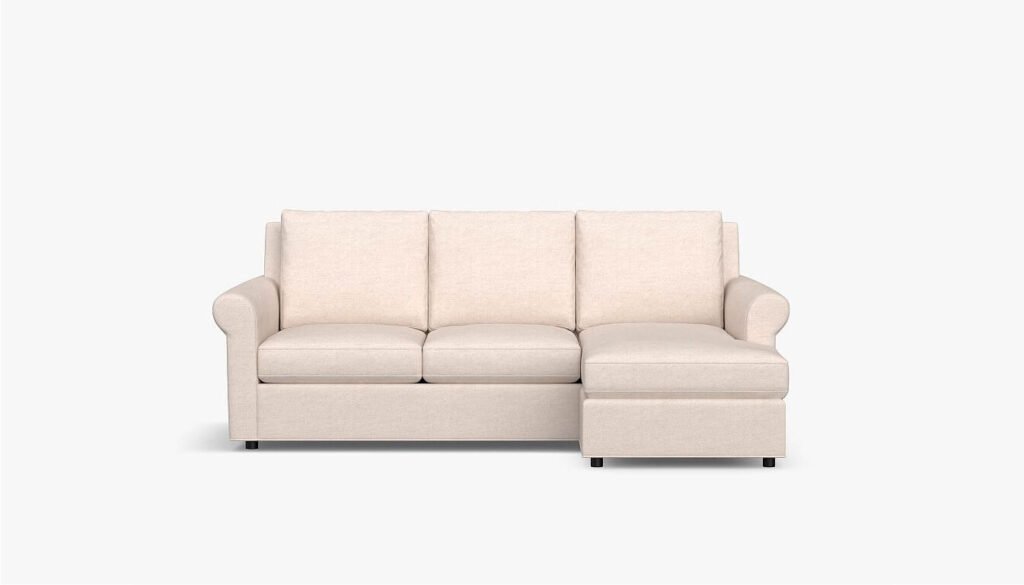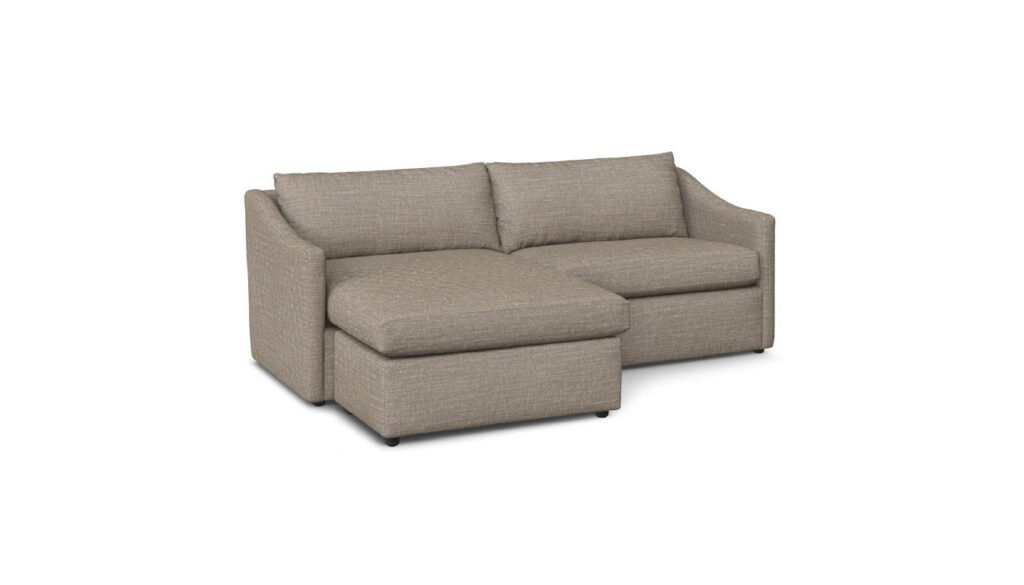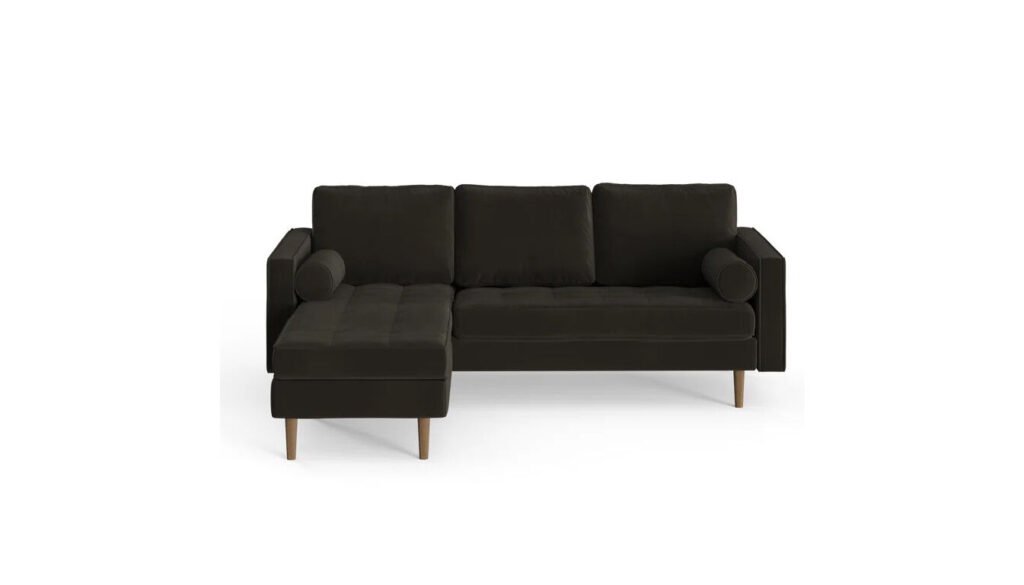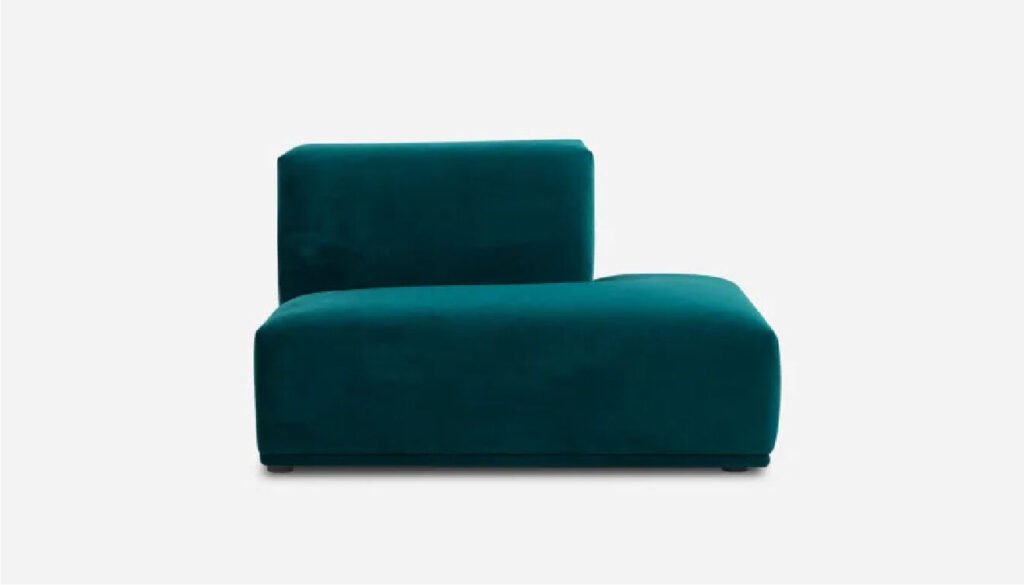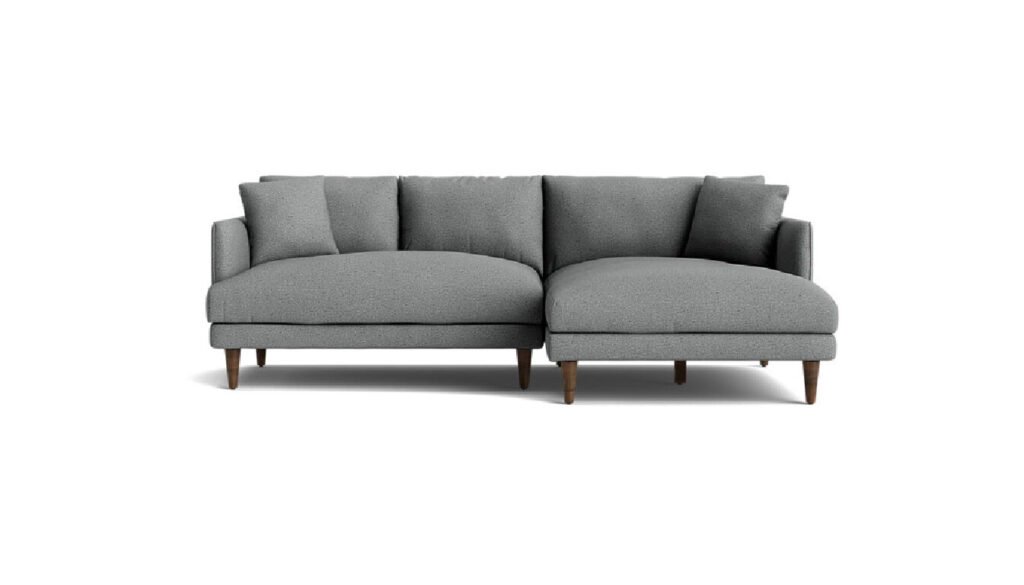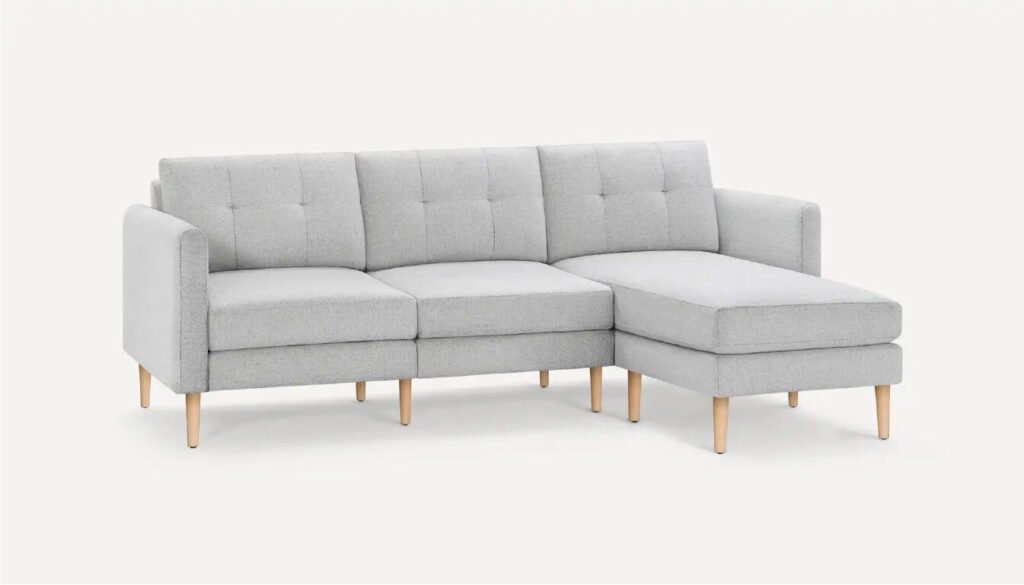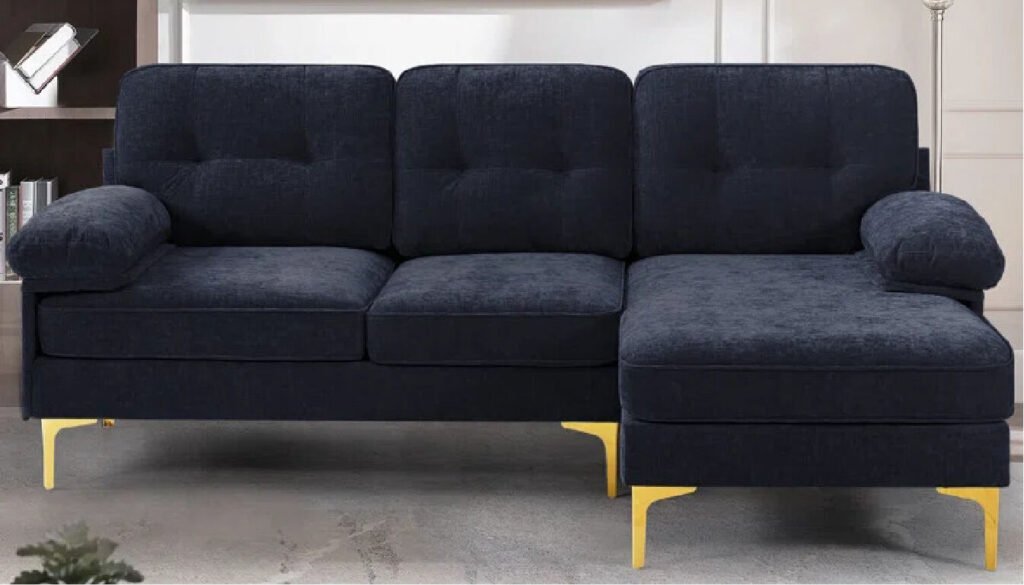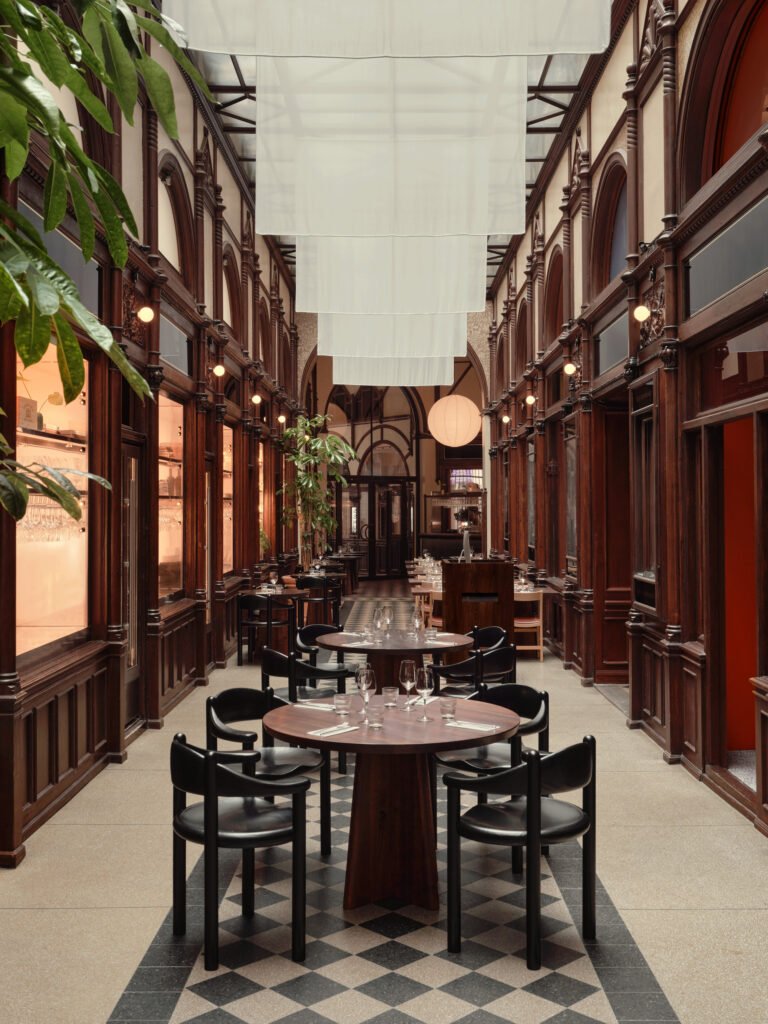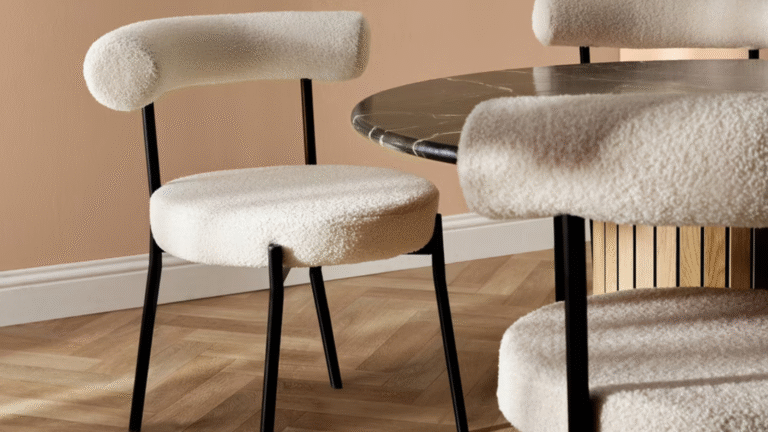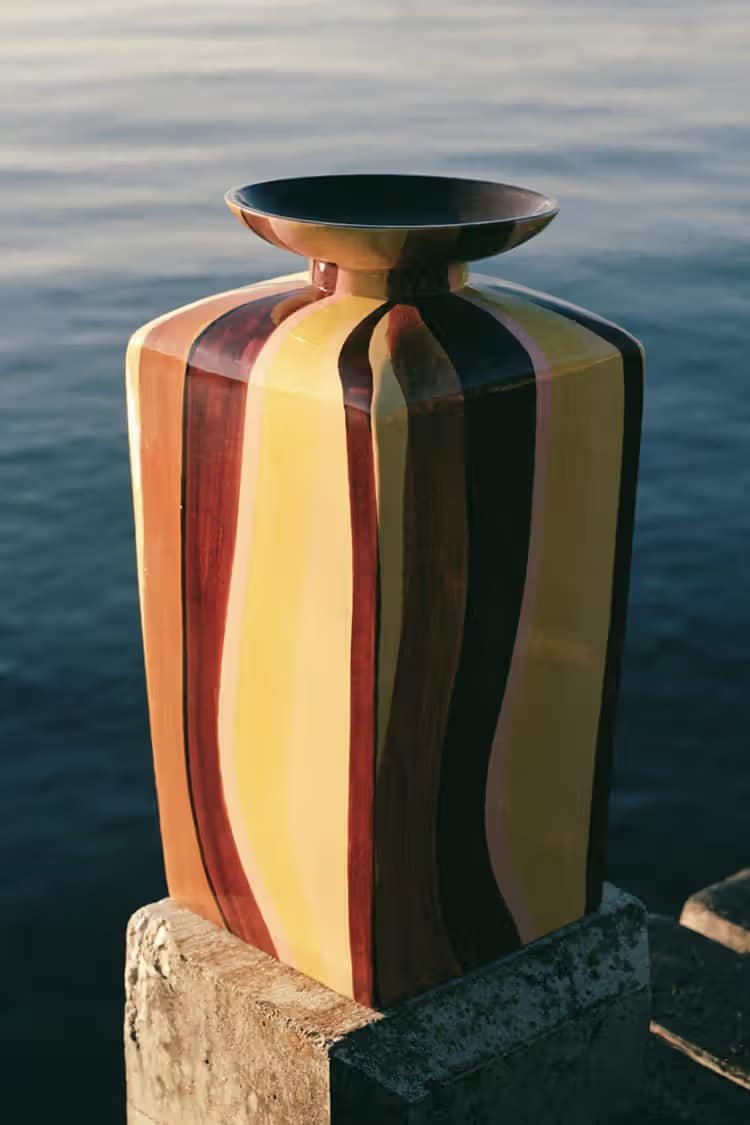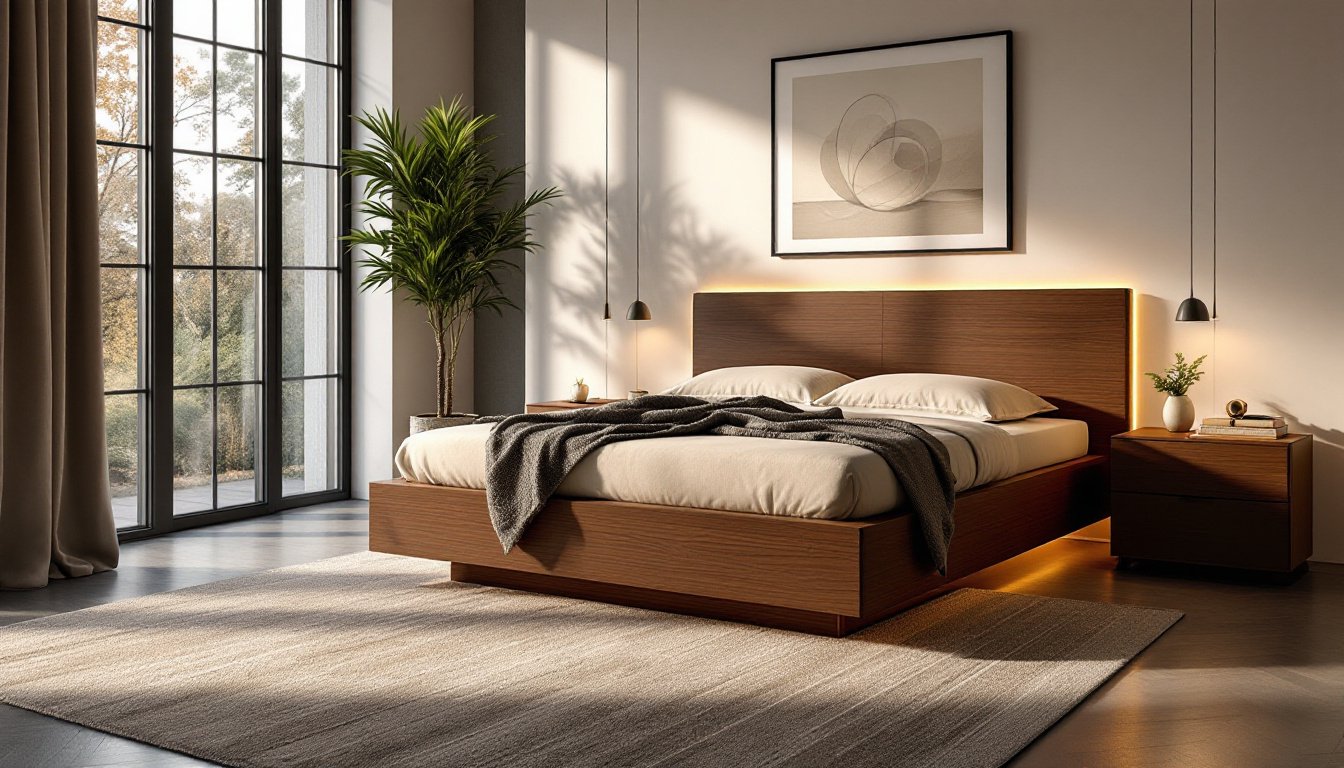I. Introduction
Finding the best sectionals for small spaces can be a game-changer for your living area. Many sofas consume too much floor space, leaving no room for accessories or walking paths. This article showcases ten compact sectionals designed to seat multiple guests and boost comfort, without sacrificing your floor plan. We’ll explore everything from modern L-shaped couches to multifunctional sleeper options, so you can achieve the perfect mix of style and function in a limited footprint.
We aim to highlight innovative designs that fit snugly into small apartments, studio layouts, or cozy dens. Each pick is curated with an eye on aesthetics, durability, and clever storage capabilities. By the end, you’ll discover how to reclaim your living room with seat configurations that blend form and function. Ready to transform your space?
Next, let’s break down common pitfalls and measurement tactics to ensure your new sectional fits seamlessly.
II. Understanding Small Space Constraints
A. Common Space Challenges
Small living rooms often present tricky corners, narrow passages, or awkward windows and radiators. You want a sectional that accommodates daily activities while leaving enough walking space. A common mistake is choosing a sofa that’s too large, making traffic flow impossible.
Another obstacle is door width. If your chosen furniture can’t squeeze through your entryway, it becomes an immediate headache. Also, balancing seating capacity with negative space is crucial: even the best sectionals for small spaces won’t help if guests feel cramped or blocked.
B. Measuring Your Living Area
Precise measurements are essential before you shop. Use a tape measure to note both length and depth, factoring in any radiator, windowsill, or shelving that juts out. For corner set-ups, measure from each wall corner to where you expect the sofa to end. If the sofa sits in an open concept area, leave enough space for foot traffic or extra furniture, like a coffee table.
Creating a basic floor plan can help visualize scale. Mark your chosen sectional’s dimensions on the floor with painter’s tape. This method is recommended by Architectural Digest, since it makes you aware of how your new piece interacts with existing elements, like TV stands or accent chairs.
C. Visualizing Scale & Proportion
A sofa that’s too tall or bulky may visually overpower your room, while a low-profile or slim-armed sectional can keep things airy. Choose a shape that complements the architecture of your space. Light-colored upholstery sometimes creates the illusion of spaciousness, and curved edges or tufted backs can soften a tight corner.
By carefully measuring and visualizing your layout, you can confidently select a sectional that fits like a glove. Next, let’s examine the key factors before making a purchase.
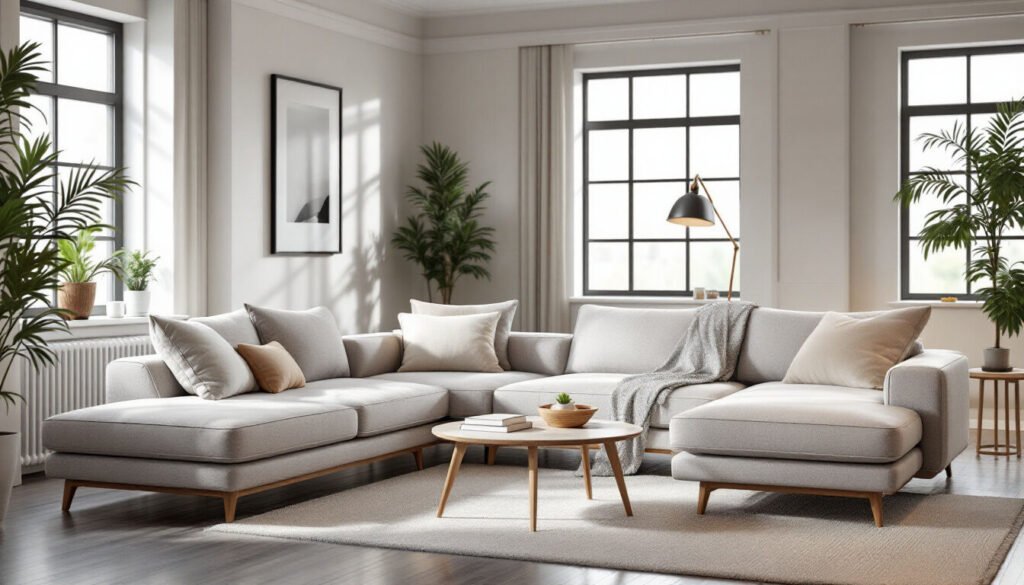
III. Key Factors to Consider When Shopping for Sectionals
A. Dimensions & Configuration
For small spaces, typical lengths range between 78 and 100 inches. Depth often measures 30 to 40 inches. L-shaped or corner sectionals slip neatly into corners, whereas U-shapes can dominate. Modular designs let you adapt seating as needs change. Reversible chaise pieces can switch from left-arm to right-arm, crucial if your layout changes after a move or renovation.
B. Style & Aesthetics
From modern small sectional looks to transitional or mid-century silhouettes, style sets the tone. Slim arms and low-profile backrests are perfect if you want an uncluttered vibe. Coordinating upholstery with existing color palettes ensures the new sofa feels intentional, not forced.
Patterns or bold textures can energize a tiny room, but if your walls or rugs are already busy, opt for solid neutrals. Tying accent pillows or throws into your overall color story helps unify the design.
C. Construction & Materials
Quality frames usually come from kiln-dried hardwood or sturdy metal. If you’re on a budget, engineered wood can suffice, but confirm it’s robust enough for daily use. Cushion fillings include high-density foam for support or a down-blend for plushness. Upholstery can range from stain-resistant polyester to leather. Performance fabrics are recommended if you have kids or pets.
D. Functionality & Extra Features
Many small sectionals integrate hidden compartments to store blankets or pillows. Sleeper sectionals let you accommodate overnight guests in a pinch. Some cutting-edge models include charging ports or USB outlets, turning your couch into a hub for electronic devices.
E. Budget & Quality
Prices vary from a few hundred dollars to several thousand, depending on brand and materials. Balancing cost with durability is vital. Waiting for sales or holiday promotions might net you a better deal. Also, read warranties to ensure you’re protected against frame or fabric defects.
With these factors in mind, let’s dive into the top 10 picks that can transform your small living room.
IV. The 10 Best Sectionals for Small Spaces
1. West Elm Eddy 2-Piece Reversible Sectional
Dimensions: Available in 74″ or 90″ widths (both ~62″ deep).
Configuration: Reversible chaise. Low profile with tapered legs.
Materials: FSC-certified wood frame, firm foam cushions, performance fabric options.
- Pros: Multiple size options, firm supportive cushions, reversible chaise, sleek modern silhouette.
- Cons: Cushions can be too firm for some, mid- to high-range price, lead time can be weeks if made-to-order.
- Ideal for: Apartment dwellers wanting a flexible sectional. Great for open floor plans where you can float or corner-place it.
2. Pottery Barn Sanford Reversible Chaise Sectional (Storage Option)
Dimensions: About 74–87″ wide (varies by arm style), ~62″ deep.
Configuration: Reversible chaise with optional hidden storage.
Materials: Solid wood frame, performance or classic upholstery, plush seat cushions.
- Pros: Hidden storage, multiple arm/finish choices, classic look, 2-3 person seating.
- Cons: Pricey, custom orders can take 6+ weeks, not easily re-reversible after initial assembly.
- Ideal for: Those seeking a quality piece with integrated storage – perfect for small spaces needing neat solutions.
3. Article Landry 84.5″ Reversible Storage Sectional
Dimensions: 84.5″ W x 61.5″ D x 34″ H.
Configuration: Reversible chaise with hidden storage.
Materials: Sturdy wood frame, medium-firm foam cushions, velvet or bouclé upholstery options.
- Pros: Modern style, chaise storage, easy assembly, removable cushion covers, good for ~2–3 adults.
- Cons: Limited color choices, seat height is slightly taller, single fixed size.
- Ideal for: Urban apartments or small houses needing hidden storage. Great for a clean, Scandinavian-inspired look.
4. AllModern Geo 84″ Reversible Sectional Sofa
Dimensions: 84″ W x 63″ D x 37″ H.
Configuration: Reversible chaise, tufted seat design, mid-century flair.
Materials: Solid wood frame, foam cushions, vegan leather or fabric upholstery.
- Pros: Stylish mid-century silhouette, budget-friendly, includes bolster pillows, quick assembly.
- Cons: Cushions can be firm, lower backrest, the ottoman might shift on bare floors.
- Ideal for: Modern small apartments seeking a tufted, retro vibe without overspending.
5. Castlery Todd Side Chaise Sofa (84″ Configuration)
Dimensions: Approx. 84″ W x 60″ D x 35″ H.
Configuration: Loveseat + chaise layout, left or right side (choose on order).
Materials: Hardwood frame, polyester/linen blend upholstery, mid-firm foam seating.
- Pros: Clean, modern lines; straightforward assembly; budget-friendly vs. some high-end brands.
- Cons: Some color limits, firm cushions at first, online-only brand for most areas.
- Ideal for: Contemporary or Scandinavian-inspired décor, ~80–90″ of space. Great for couples or smaller living rooms.
6. Joybird Lewis Apartment Sectional (2-Piece)
Dimensions: ~91″ W x 61″ D x 32″ H (apartment-size version).
Configuration: 2-piece L-shape, left- or right-arm chaise. Deep seat cushions.
Materials: Kiln-dried hardwood frame, foam + poly fiber cushions, multiple custom fabrics.
- Pros: Extremely comfortable deep seat, stylish mid-century design, lifetime frame warranty, many fabric choices.
- Cons: Made-to-order means long lead times, higher price range, low back height.
- Ideal for: Mid-century fans wanting a plush sectional that still fits smaller living rooms. Perfect for reading or lounging.
7. IKEA Friheten Sleeper Sectional
Dimensions: 90.5″ W x 59.5″ D x 26″ H.
Configuration: Reversible chaise, pull-out sleeper, large hidden storage.
Materials: Engineered wood frame, foam cushions, poly-fabric upholstery.
- Pros: Highly versatile (bed + storage), affordable, large color selection, proven popular design.
- Cons: Assembly is fairly involved, bed firmness is average, basic styling.
- Ideal for: Smaller homes needing a guest sleeping solution. Great for studios or multi-use living rooms.
8. Burrow Nomad Sofa Sectional (Chaise)
Dimensions: ~85″ L x 61″ D x 33″ H.
Configuration: Modular seat segments, reversible chaise, optional built-in USB charger.
Materials: Pine + engineered wood frame, medium-firm foam cushions, scratch-resistant fabric.
- Pros: Easy to assemble and move, flexible modules, hidden USB/power outlet add-on, lifetime warranty on frame.
- Cons: Seat depth is moderate, not extremely plush, some might find the look too minimalist, mid-high price.
- Ideal for: Renters or owners who relocate often; small living rooms requiring a modern, tech-friendly solution.
9. Wayfair (Mercer41) Rhylin 82″ Reversible Sectional
Dimensions: 82.7″ W x 51.2″ D x 34.3″ H.
Configuration: 2-piece sofa + ottoman; chaise can be formed on left or right.
Materials: Chenille upholstery, fiber-filled back cushions, engineered wood frame.
- Pros: Extremely cozy chenille fabric, smaller than 83″ wide, easy on the budget, quick shipping from Wayfair.
- Cons: Assembly takes patience, plastic legs, seat is firm at first, limited color range beyond neutrals.
- Ideal for: Very tight living rooms, studio apartments, or short-term rentals. Great for a comfy lounge vibe on a low budget.
10. Wade Logan Andrielle 79″ Reversible Modular Loveseat Chaise
Dimensions: 79″ W x 69″ D x 34″ H.
Configuration: Loveseat plus chaise ottoman, reversible for left or right side.
Materials: Corduroy (or similar textured fabric), foam cushions, standard wood + metal bracket construction.
- Pros: One of the smallest full “sectionals” around, super cozy fabric, easy to move, perfect for 2–3 people.
- Cons: Low back, firm seats, limited color stock. Slightly specialized style due to the corduroy. It sells out fast.
- Ideal for: Tiny apartments or large bedrooms. Possibly the best sectional for truly tight corners while still having a chaise for relaxing.
Now that we’ve introduced each contender, let’s compare them directly.
V. Comparison of the 10 Sectionals
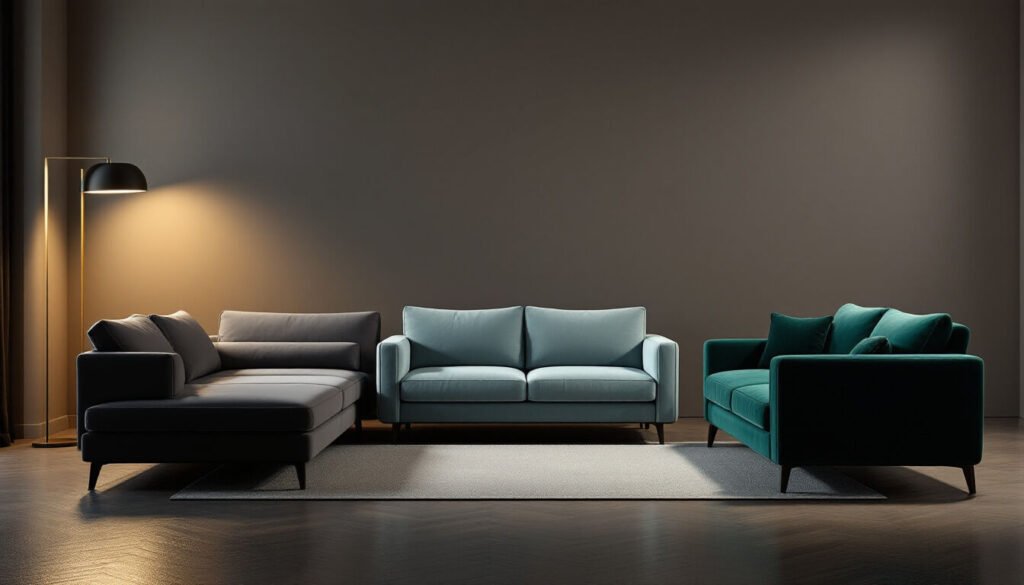
A. Quick Reference Comparison Table
Below is a concise overview (dimensions, price range, special features). Each category helps you evaluate which fits your needs best:
- Dimensions: Ranging from around 78” wide (budget options) up to 90” (premium picks)
- Price Range: ~\$500 to \$2,500+
- Upholstery: Performance fabric, leather, velvet, or linen blends
- Features: Storage chaise, reversible configurations, sleeper modules, USB charging ports
Remember to cross-check your floor plan and typical usage. If you have pets, a performance fabric might be a must. Or if you often host overnight guests, a sleeper could be non-negotiable.
B. Choosing the Right Sectional Based on Individual Needs
Pet owners might pick something with scratch-resistant fabrics. Eco-conscious buyers lean toward recycled or organic materials. Trend seekers prefer modern silhouettes, while classic enthusiasts might pick tufted backs and rolled arms.
If budget is the main concern, focus on mid-range or sale items. Meanwhile, an investment piece could last a decade or more, providing comfort for years.
C. Common Pitfalls to Avoid
Many new owners forget to measure doorways. Also, picking a sectional that’s too large can overshadow the entire room. Another common error is ignoring the importance of quality materials, leading to sagging cushions or frame issues quickly.
Next, let’s discuss how to arrange these pieces effectively in small living rooms.
VI. Top Tips for Arranging Sectionals in Small Rooms

A. Utilizing Corners and Nooks
If the sectional is L-shaped, place it flush against two adjoining walls, maximizing corners. Alternatively, some prefer “floating” the sofa a few inches from the wall to visually carve out separate functional zones, which can help in open layouts. According to Living Cozy , this approach can make a tiny space feel bigger and more dynamic.
B. Accessorizing Without Clutter
Try compact coffee tables or nesting tables. If you add side tables, choose ones with a narrow profile or built-in shelving for extra storage. Keep decorative items minimal and purposeful. Tall shelving or wall-mounted shelves free up floor area while offering style continuity.
C. Lighting and Color to Enhance Space
Neutral or pastel upholstery can visually expand the room. Add color pops in throw pillows or rugs for interest. Bright overhead lighting, combined with a floor lamp or table lamp, ensures the seating area is well-lit. Mirrors on an adjacent wall can reflect both light and the sofa, adding an illusion of depth.
By blending strategic placement with thoughtful accessories, you’ll make the most of your small sectional setup. Next, we’ll explore maintenance tips.
VII. Maintenance and Upkeep
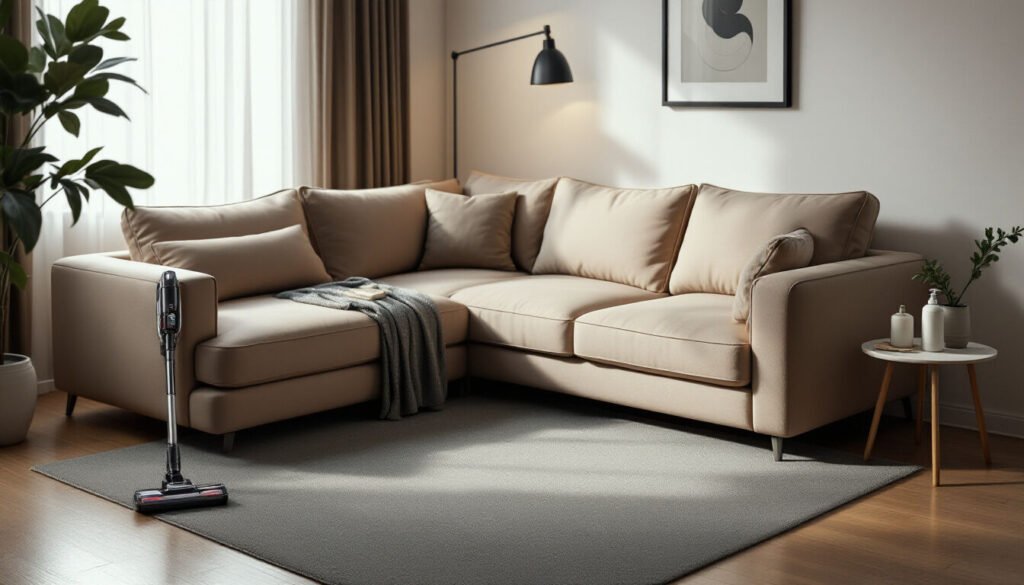
A. Daily Care Rituals
Light vacuuming or lint-rolling helps remove dust, crumbs, and pet hair. Plump seat and back cushions if needed. If your sectional has moving modules, align them occasionally to maintain a clean, cohesive appearance.
B. Stain & Spill Protection
Many stain-resistant fabrics are spot-cleanable with mild soap. Leather requires occasional conditioning to prevent dryness or cracking. According to Bellona USA , keep leather away from direct sun. For performance fabrics, blot spills quickly with a gentle cloth, avoiding harsh scrubbing.
C. Prolonging the Lifespan
Protect floors with rug pads or furniture cups if you shift the sofa often. Check that any screws or legs remain tight. Rotating seat cushions, especially if your sectional sees frequent use in the same spots, ensures even wear.
With upkeep in mind, a well-built small sectional can last years. Let’s finalize by reiterating our top picks and concluding advice.
Conclusion
In this roundup of the 10 best sectionals for small spaces, we explored a range of solutions, from budget-friendly reversible chaises to premium modular sets brimming with extra features. The common thread is a blend of compact sizing, functional design, and style that elevates cozy living quarters.
As you shop, remember to measure meticulously, confirm the sectional’s configuration, and weigh extra features like storage or sleepers. By balancing comfort, aesthetics, and your actual floor plan, you can transform even the tightest corners into welcoming conversation spots. Ultimately, the perfect sectional fosters relaxation and style, without overwhelming your precious square footage.
Now, let’s address some frequently asked questions to tie up any loose ends.
IX. Frequently Asked Questions (FAQs)
1. What are the ideal dimensions for a small sectional sofa?
Typically, look for widths between 78 and 100 inches. Depths around 30 to 40 inches suit limited spaces. Always measure your room thoroughly before buying.
2. How do I choose a fabric that’s both stylish and stain-resistant?
Consider performance fabrics like Crypton, polyester blends, or solution-dyed acrylic. They resist spills and remain easy to wipe clean while offering various color choices.
3. Can I find budget-friendly yet durable sectionals for small living rooms?
Yes. Many retailers offer mid-priced sets with solid frames and standard foam cushions. Look for sales or clearance events to get high-quality at a lower cost.
4. Is a sleeper sectional practical for tiny apartments or studios?
Absolutely, if you host overnight guests. Check folded dimensions so the bed can be deployed without blocking doorways or traffic flow.
5. How can I make sure my new sectional fits through narrow doorways?
Measure door frames, hall widths, and corners. Some sectionals have removable legs or backs for easier navigation. Request “white glove” delivery if you’re concerned about assembly or setup.
If you need more small-space living ideas, check out our smart apartment design tips guide. Thanks for reading, and may your new compact sectional brings style and comfort to your home!



